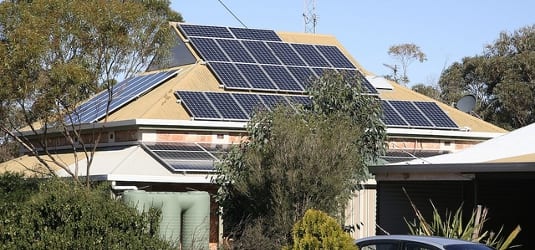Australia could install solar PV on every suitable residential rooftop in the country without causing any problems for the running of the national grid, according to the chief scientist of global PV major Trina Solar.
Pierre Verlinden – a Belgian-born Australian who, through his research work at the China-based Trina has collaborated with the UNSW and ANU – told RenewEconomy he was “totally convinced” that Australia could shift to 100 per cent renewable electricity, through a combination of distributed and large-scale solar PV and wind energy.

Verlinden – who has seen the global solar market grow 60,000-fold over the 17 years he’s been working in the industry – said that, at the very least, he hoped Australia would introduce legislation like that recently adopted by San Francisco, where all new-build houses are now required to have a PV system installed.
“I hope the (rooftop solar) market in Australia will continue growing,” Verlinden told RenewEconomy in an interview from his base in China.
“The advantage of PV is it is the most distributed source of energy, and we need to take advantage of that. We need to put PV on every roof. That would easily support up to 25 per cent of household demand, and with battery storage, up to 100 per cent.
“I think you have the political will, but you have too much lobbying coming in the other direction,” he said, referring to Australia’s coal power industry, which has and continues to dominate the nation’s generation mix.
One of the main arguments used by incumbent network operators and power generators against a higher penetration of rooftop solar in Australia is that it will be too much for the current grid, which was designed around the concept of centralised fossil fuel generation.

Most recently we have seen this myth trotted out in Alice Springs, where the local utility – and the NT government – have claimed that the local network can not support any increase in solar PV.
“Then comes the sun, or the wind starts to blow, and suddenly the cables are overloaded, they heat up, melt, collide and fail. Brownouts or blackouts are the result,” said Northern Territory treasurer Dave Tollner, in the local paper.
Of course, as we have noted here and various studies have shown, this is simply not accurate.
“What we say in China,” Verlinden told RE, “is that this is BS – but we say it politely in Chinese.
“It’s not true. You could demonstrate it clearly that there is absolutely no problem to go 25 per cent PV, 25 per cent wind and there is no issue, absolutely no issue at all.
“South Australia wants to go to 100 per cent, and they will do it,” he added.
“Solar PV is the most distributed source of energy, so why would you need to update your transmission line? It doesn’t make sense.”
On the other hand, Verlinden added, “If you put in a 1.2GW coal power plant in a place that is far away from where most of its power needs to be delivered, that’s when you need to build new infrastructure.
“I think the utilities are using that as an excuse to get money from the government.
“But the utilities also want PV. They’re not stupid. It’s cheaper than almost any other source of energy. But they also want to control it.
“They want to convince the government that you need the utilities need to control it.”
Of course, Verlinden added, “as the producer of PV panels, we don’t care who installs it.
However it plays out, “there has been a change to the business model, a change to the energy economy,” he said.
“PV is the people’s choice of energy. It’s a train that nobody can stop.”








